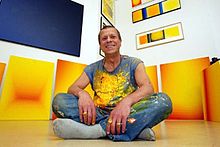Günter Scharein
Günter Scharein (born April 27, 1949 in Bassum / Lower Saxony) is a German painter. His chromatic works, developed from color field painting , are created in Berlin , where he has lived and worked since 1972.
Perfect application of paint, rasterization, calculation and an analytical approach are the basis of constructive-concrete art. Scharein also understands his works as content-related, emotional color plates and reinforces this with his picture titles such as "Sacral" or "Longing Triptych". Scharein's works are in private and public collections at home and abroad.
Life
After graduating from high school, Scharein studied art education at the art schools in Hamburg with Fritz Seitz and Bazon Brock and in Saarbrücken with Oskar Holweck . In 1979 he moved to the University of the Arts in Berlin, where he became a master student under Johannes Geccelli and Herbert Kaufmann . In 1979/1981 he passed the first and second state exams for teaching at grammar schools and worked as an art teacher at the Menzel Oberschule in Berlin. From 1981 to 1983 he received a studio grant from the Karl Hofer Society in Berlin. In 1988 he gave up his job as a teacher and has been working as a freelance painter ever since.
Developments and works
Cardboard work
Already in the run-up to his studies as an art teacher, Scharein started around 1968 with a strictly serialized image concept reduced to black and white contrasts. Scharein starts out from the square as a basic module and sets this in motion optically by shifting the black and white contrast or by plastic modifications.
screen printing
Scharein does not use screen printing to produce edition graphics, but creates unique pieces by creating "screen-printed works" in the course of hundreds of printing processes. The artist develops a meticulously controlled, horizontal and vertical stripe technique. This interweaves the colors yellow, red, green and blue into a dense image plan, which fascinates at a distance with a rhythmically increasing and decreasing color movement. On closer inspection, a microstructure made up of thousands of thin or broader colored lines is astonishing. In one of the last screen-printed works "Great Rousseau" from 1981, the jungle fantasies of the French Henri Rousseau are implemented in several hundred different shades of green.
Color work
At the end of the 1970s, Scharein switched from screen printing to colored brushwork, with which he could explore the depth of the color in a new quality. The line technique of screen printing will initially be continued, based on a horizontal or vertical strip grid. A coherent series of pictures from around 1985 has been developed from the complementary contrast of red and green. At the same time he created the more chromatically conceived paintings in which the dot grid, which has been further developed to this day, replaces the previous stripe technique. As in the screen printing process, the images are created by superimposing several different color sequences. From a distance, the dotted fine-tuning merges into wide, homogeneous and seemingly monochrome surfaces. However, each of these processes is composed of many hundreds of individual color tones and thousands of individual points. Up to 17 different color points are applied to one cm².
Altarpieces
In 1979 the first attempt at an altarpiece was made, which was the beginning of a whole series of triptychs . With the modulation of a color tone, Scharein succeeds in depicting figures, if one is prepared to understand the figure not only as a realistic representation of the body. The content in his altarpieces is created by the color figures and the image compositions.
Important individual work
"Master Mathis"
Scharein's color research in the mid-1980s, guided by scientific meticulousness, is connected with a spiritual charge via image titles and motivic echoes and in 1985 led to the two-year triptych "Hommage à Meister Mathis", a central work in the work of the Berlin artist. Using abstract, ascending and descending color movements, Scharein has compiled the Annunciation, the Crucifixion and the Resurrection of the Isenheim Altarpiece in his picture. To this day, Scharein continues the theme of the altarpiece with large-format chromatic works, the light energies of which radiate into the viewer's room from a deep blue or a sunny yellow. The consistency and the great breath of Scharein's pictures result in references to the monumentally conceived, spiritual monochrome pictures by Mark Rothko , Barnett Newman or Ad Reinhard.
"Symphony in Yellow"
The “Symphony in Yellow” is the artist's largest work to date, on a total of five panels measuring 202 × 750 cm. The work was created between 2003 and 2005. Scharein describes this work as a “musical symphony”, which usually consists of three to five movements. “My 'Symphony in Yellow' developed out of three big movements: earthly, floating, ascending - connected by two small interludes. The light color yellow should be perceived almost physically in its concentrated energy, its vivid qualities evoke associations and emotions in the viewer. "
literature
- Andreas Mertin: “Do you also perceive what you see?” - A small visual school using the example of the Isenheim Altarpiece; in: teaching religion. Information for religious teachers in the Diocese of Hildesheim, 2/2005.
- Jürgen Leinemann : Points, interview with Günter Scharein, October 14, 2006 in Berlin; ISBN 978-3-8030-3318-5 .
- Stefan Hansen and Edzard Reuter: SCHAREIN - An artist portrait, Berlin 2007; ISBN 978-3-8030-3318-5 .
- Edzard Reuter : Günter Scharein - The price of incorruptibility, in: The narrow ridge of life: Encounters and events; Stuttgart 2007; ISBN 978-3-89850-159-0 .
Web links
- Literature by and about Günter Scharein in the catalog of the German National Library
- www.scharein.de: Web presence of the artist
| personal data | |
|---|---|
| SURNAME | Scharein, Günter |
| BRIEF DESCRIPTION | German painter |
| DATE OF BIRTH | April 27, 1949 |
| PLACE OF BIRTH | Bassum |





